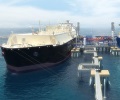Russian gas flows into Europe dip in April as Ukraine war rumbles on

Physical Russian gas flows into Europe dropped back in April compared with the previous month, an analysis of flow data from S&P Global Commodity Insights showed May 6, but supply remained above January and February levels as the war in Ukraine rumbled on.
Russian pipeline exports to Europe last month via its four main corridors — Nord Stream, Yamal-Europe, Ukraine and the TurkStream string to Europe –totaled 8.27 Bcm, the data showed.
That is down on the 9.79 Bcm of supply in March, when deliveries via Ukraine rebounded at times to the contractual maximum on favorable price spreads.
April supplies were, though, higher than the 7.26 Bcm of exports in January and 7.79 Bcm in February despite a continued crunch on Russian gas flows via Belarus.
Flows via the Yamal-Europe route were strongly constrained from late December due to the pipeline operating mostly in reverse mode eastward from Germany to Poland.
Russia’s Gazprom halted gas supplies to Poland and Bulgaria on April 27, with the true impact on overall Russian gas deliveries to Europe likely to be seen only in May.
The cut-off triggered new concerns on the European gas market over Russia, leaving gas prices at sustained highs.
The TTF month-ahead price reached a record high of Eur212.15/MWh on March 8, according to Platts assessments by S&P Global.
The contract was last assessed on May 5 at Eur107/MWh, still 365% higher on the year.
Ukraine transit
Flows via Ukraine dropped back in April, with deliveries into the key entry point on the border with Slovakia at Velke Kapusany averaging just 57 million cu m/d, S&P Global data showed.
The fall in supplies via Ukraine in April was likely a result of European spot prices dropping below the price of Gazprom contracted gas, leading buyers to nominate down their Russian purchases.
Supplies via Velke Kapusany had averaged 78 million cu m/d in March as flows into Europe via Ukraine rose to the contractual maximum after the invasion triggered sharp spot price increases in Europe, making Gazprom’s contracted gas more competitive versus gas at the European hubs.
Total Russian deliveries via Ukraine in all pipelines in March were as high as 110 million cu m/d, in line with Gazprom’s contractual obligations under its five-year transit deal with Ukraine signed in December 2019.
Under those transit arrangements, Gazprom agreed to transit 65 Bcm of gas via Ukraine in 2020 and 40 Bcm/year in the period 2021-24, well down on a recent transit peak of 94 Bcm in 2017.
In 2021, Gazprom delivered 41.6 Bcm of gas via Ukraine, having topped up its contractual obligations with some shorter-term bookings.
TurkStream flows
Supplies via TurkStream in April were also lower at 0.85 Bcm, the S&P Global data showed, having been above 1 Bcm for the four preceding months.
Flows at the Strandzha entry point on the border between Turkey and Bulgaria fell to as low as 21 million cu m/d on April 27 when Gazprom halted deliveries under its long-term contract with Bulgaria’s Bulgargaz.
That is well down on the flows of up to 43 million cu m/d seen toward the end of 2021, S&P Global data showed.
Total gas deliveries into Southeast Europe via TurkStream in 2021 amounted to 11.6 Bcm, or an average of 32 million cu m/d.
The start in January 2020 of the two-string 31.5 Bcm/year TurkStream pipeline triggered an unprecedented reshuffle in the way Russian gas reaches Southeast Europe.
One of the 15.75 Bcm/year strings feeds directly into the Turkish market, replacing volumes previously delivered via Ukraine in the Trans-Balkan pipeline, for which data is not available, while the other 15.75 Bcm/year string enters Bulgaria at Strandzha.
Initially, gas mostly either stayed in Bulgaria or was transited to Greece and North Macedonia, with small volumes also moving into Romania.
However, since the start of 2021, Russian gas sent via TurkStream is also now transited on to Serbia, Bosnia and Herzegovina, with Hungary also supplied via the new route since October 2021.
Romania is mostly supplied with Russian gas via TurkStream, but in the first quarter also resumed small imports at the Isaccea entry point on the border with Ukraine.
Flows via Isaccea were zero again in April, however. Imports via Isaccea were halted from April-December last year due to the shift to imports via TurkStream.
Source: Platts

 Hellenic Shipping News Worldwide Hellenic Shipping News Worldwide, Online Daily Newspaper on Hellenic and International Shipping
Hellenic Shipping News Worldwide Hellenic Shipping News Worldwide, Online Daily Newspaper on Hellenic and International Shipping





















 PG-Software
PG-Software